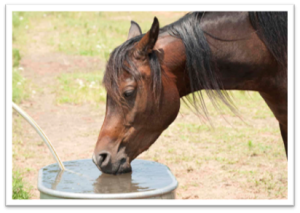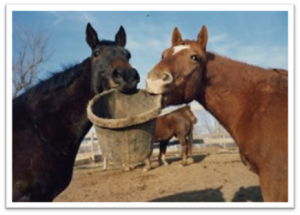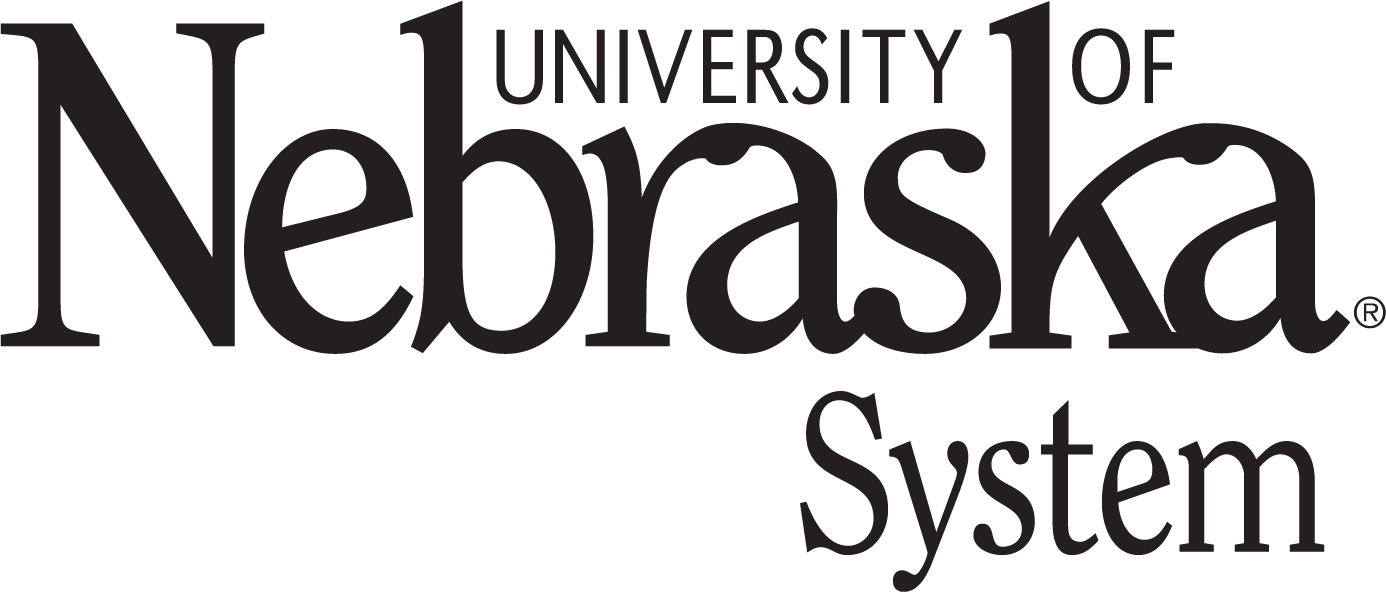1.5 Horse Health
We will now shift our discussion to topics related to maintaining feedyard horses’ health including their feet, nutrition, vaccinations and overall care. Work through this activity to learn more. Clicking on the arrows in the lower right corner will maximize the activity’s view. Pressing “escape” will return you back to this location.
Worn shoes, like worn out treads on your boots, can cause trips and falls – injuring both horse and rider. What is the shoeing schedule at your feedyard? If a horse throws a shoe, what is the procedure for replacement?
Horse Nutrition
When considering what to feed horses, the type of horse and the type of work need to be considered. Feedlot horses are considered to be in the mature working class with a moderate work intensity.
 The most important nutrient is water, and it needs to be clean and fresh.
The most important nutrient is water, and it needs to be clean and fresh.
- Mature idle horses drink 10-12 gallons per day.
- Provide cool water in the summer and warmer water in the winter.
- Salt is also important, especially for horses that sweat a great deal. Trace mineral salt is available in a block. It is best kept off the ground.
- To reduce the potential for ulcers in the horse, if possible, feed the hay before the grain.
FEED BY WEIGHT NOT VOLUME
-
- All hay diets: Require 2% of their body weight/day
- Grain and hay combination per lb. of body weight: Hay is 2.0%, Grain is 0.75 -1.5%

- If feeding groups of horses together, be aware of pecking orders and feed at least 30 feet apart.
- Do not feed horses moldy or dusty hay as these can cause colic and respiratory problems. Also don’t allow horses to eat from the round bale, as they well bury their nose into the bale to chase sweeter feed. If the hay bale has moldy hay or old hay deeper inside, the horse can get respiratory problems or colic.
Never let a hot horse have grain or free-choice water. Wait at least 2 hours before or after heavy exercise; otherwise it can result in laminitis (founder) or colic. They can have all the hay they want.
Rule of thumb: You should NOT be able to see a horse’s ribs. However, you should be able to feel their ribs. Watch for horses that drop grain because they may have sores on the inside of their mouths or tongue. Routine dental care should be provided and horses’ teeth floated as necessary.
Rumensin is deadly to horses, do not let horses eat out of cattle bunks!
Review
Work through these interactive questions to review the important concepts discussed.
A type of salt block that contains essential minerals needed for a horse's health. It provides important nutrients such as zinc, copper, and iodine, and is often used to supplement a horse's diet, especially when they sweat heavily.
A term used to describe abdominal pain in horses, which can be caused by various digestive issues. Symptoms of colic can include rolling, pawing, and restlessness, and it requires immediate veterinary attention.
A painful and potentially serious condition affecting the hooves of horses, caused by inflammation of the laminae. It can result from various factors such as excessive intake of grain, lush pasture, or sudden changes in diet and requires immediate veterinary care.
When a horse's teeth are floated, this is a procedure in which a veterinarian dentist removes sharp edges from the horse's teeth and checks their mouth for any other concerns.
A feed additive used in cattle to improve feed efficiency and control coccidiosis. It is toxic to horses and can cause severe illness or death if ingested, so it's crucial to keep horses away from cattle feed containing Rumensin.
